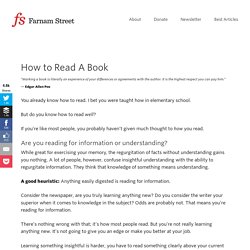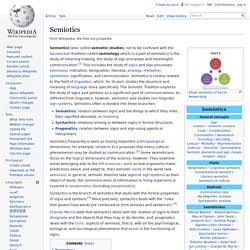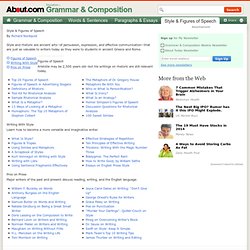

How to Read A Book. “Marking a book is literally an experience of your differences or agreements with the author.

It is the highest respect you can pay him.” — Edgar Allen Poe You already know how to read. I bet you were taught how in elementary school. But do you know how to read well? If you’re like most people, you probably haven’t given much thought to how you read. Are you reading for information or understanding? While great for exercising your memory, the regurgitation of facts without understanding gains you nothing. A good heuristic: Anything easily digested is reading for information. Consider the newspaper, are you truly learning anything new? There’s nothing wrong with that; it’s how most people read. Learning something insightful is harder, you have to read something clearly above your current level. Reading for understanding means narrowing the gap between reader and writer. The four levels of reading Mortimer Adler literally wrote the the book on reading.
ElementaryInspectionalAnalyticalSyntopical. 19 Outstanding Words You Should Be Working Into Conversation. There are some of our favorite words that appeared in mental_floss stories in 2011. Some are foreign words. Others come from medical dictionaries. And there's a surprising amount of hobo slang. Have fun working these into conversation this holiday season! Gene Lee / Shutterstock.com 1. 2. 3. 4. milliHelen: The quantity of beauty required to launch just one ship. The Top 10 Relationship Words That Aren't Translatable Into English. Here are my top ten words, compiled from online collections, to describe love, desire and relationships that have no real English translation, but that capture subtle realities that even we English speakers have felt once or twice.

As I came across these words I’d have the occasional epiphany: “Oh yeah! That’s what I was feeling...” Mamihlapinatapei (Yagan, an indigenous language of Tierra del Fuego): The wordless yet meaningful look shared by two people who desire to initiate something, but are both reluctant to start. Oh yes, this is an exquisite word, compressing a thrilling and scary relationship moment. It’s that delicious, cusp-y moment of imminent seduction. Yuanfen (Chinese): A relationship by fate or destiny. From what I glean, in common usage yuanfen means the "binding force" that links two people together in any relationship. But interestingly, “fate” isn’t the same thing as “destiny.” Retrouvailles (French): The happiness of meeting again after a long time.
38 Ways To Win An Argument—Arthur Schopenhauer - The India Uncut Blog - India Uncut. For all of you who have ever been involved in an online debate in any way, Arthur Schopenhauer’s “38 Ways To Win An Argument” is indispensable.

Most of these techniques will seem familiar to you, right from questioning the motive of a person making the argument instead of the argument itself (No. 35), exaggerating the propositions stated by the other person (No. 1) , misrepresenting the other person’s words (No. 2) and attacking a straw man instead (No. 3).
It’s a full handbook of intellectual dishonesty there. Indeed, I generally avoid online debates because they inevitably degenerate to No. 38. The full text is below the fold. Many thanks to my friend Nitin Pai for reintroducing me to it. 38 Ways To Win An Argumentby Arthur Schopenhauer 1 Carry your opponent’s proposition beyond its natural limits; exaggerate it. Semiotics. Semiotics frequently is seen as having important anthropological dimensions; for example, Umberto Eco proposes that every cultural phenomenon may be studied as communication.[2] Some semioticians focus on the logical dimensions of the science, however.

They examine areas belonging also to the life sciences – such as how organisms make predictions about, and adapt to, their semiotic niche in the world (see semiosis). In general, semiotic theories take signs or sign systems as their object of study: the communication of information in living organisms is covered in biosemiotics (including zoosemiotics).
Syntactics is the branch of semiotics that deals with the formal properties of signs and symbols.[3] More precisely, syntactics deals with the "rules that govern how words are combined to form phrases and sentences".[4] Terminology[edit] Ferdinand de Saussure, however, founded his semiotics, which he called semiology, in the social sciences: History[edit] Formulations[edit] Branches[edit] Notes. Style and Figures of Speech - Understanding Figurative Language - Writing Persuasive Prose. Education Grammar & Composition Share this page on: Send to a Friend via Email Your suggestion is on its way!

An email with a link to: was emailed to: Thanks for sharing About.com with others! Most Emailed Articles Weight lost made easierHow Jurassic Park Lied to Us About Dinosaur CloningCan Animals Sense Natural Disasters? Stijlfiguren. Top 20 Figures of Speech - Figurative Language - Definitions and Examples of Figures of Speech. By Richard Nordquist Updated September 22, 2015.

A figure of speech is a rhetorical device that achieves a special effect by using words in distinctive ways. The Big Quiz on Figures of Speech in Advertising Slogans - Advertising Figures - Rhetorical Terms - Quiz. BIGIDEAS Stephen Pinker. Elif Shafak: The politics of fiction.